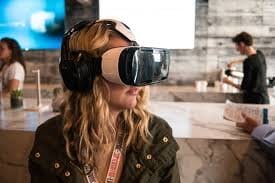A recent Bloomberg article examined the latest tech initiatives that many businesses are taking to engage their customers and improve the buying process, especially in brick and mortar stores. Stores like Lowe’s are using VR headsets to help shoppers visualize how certain items will look in their house, and clothing stores are starting to put interactive smart mirrors into their dressing rooms. However, citing research from GPShopper and YouGov, the piece came to the conclusion that shoppers don’t care that their favorite stores have advanced technology available to them, and that all they want is to be able to purchase things as quickly and easily as possible.
While this may sound very alarming to those in the customer experience space, there are two primary reasons for these results.

The first reason is pretty simple: awareness. Like the article states, many times the shoppers aren’t aware that the technology even exists, or they might not realize that it will actually be helpful to them. While customers are now more informed about products and technological development than they ever have been, it is unreasonable to expect them to be aware of how the new technology offerings can actually benefit them or how they even work. Offerings like smart mirrors and VR stations in stores are in a state similar to the iPhone was when it first came out: customers don’t realize that they want to use something like that because most have never had any experience with something so advanced. They may think these features are too complicated and unnecessary, but once they integrate more advanced levels of technology into their daily lives, beyond phones and computers, they will soon see the value. For now, it is up to brands to demonstrate to customers how the new offerings will promote the end goal of a fast and easy customer experience.
The second factor holding some of this technology back is its effectiveness. As highlighted throughout the article, customers want quick and effortless experiences above all else; anything not related to that end goal is mere fluff. Therefore, without the proper deployment of technology, it might not be clear to customers that these tools are there to help them achieve their goal. Much like Tom Asher wrote in last week’s post, having the technology isn’t enough, it has to be the right technology. When automation, AI, chatbots, etc. are used to assist the customer when they need more information or are hesitating to commit to the purchase, then the true power of technology can be seen.

However, companies must not deploy technology for technology’s sake. Sure, it might be great to tell customers that your brand has a fully automated chatbot assistant on its website, but if it cannot understand language or function properly, then it is doing more harm than good (much like the ASOS example used in the Bloomberg article). While some automated technologies can operate autonomously, most still require human guidance and tuning to ensure that they fulfill their purpose. Humans must monitor these automated processes so that, if needed, they can correct errors or even step in and handle transactions when the quality of the experience is waning. AI, automation, and machine learning have vastly improved customer experience capabilities, yet brands must not forget that for the foreseeable future humans will still be needed to make sure that the customer’s ultimate goals are being met.
Want to make sure you have the right technology for your customers? Start here.


